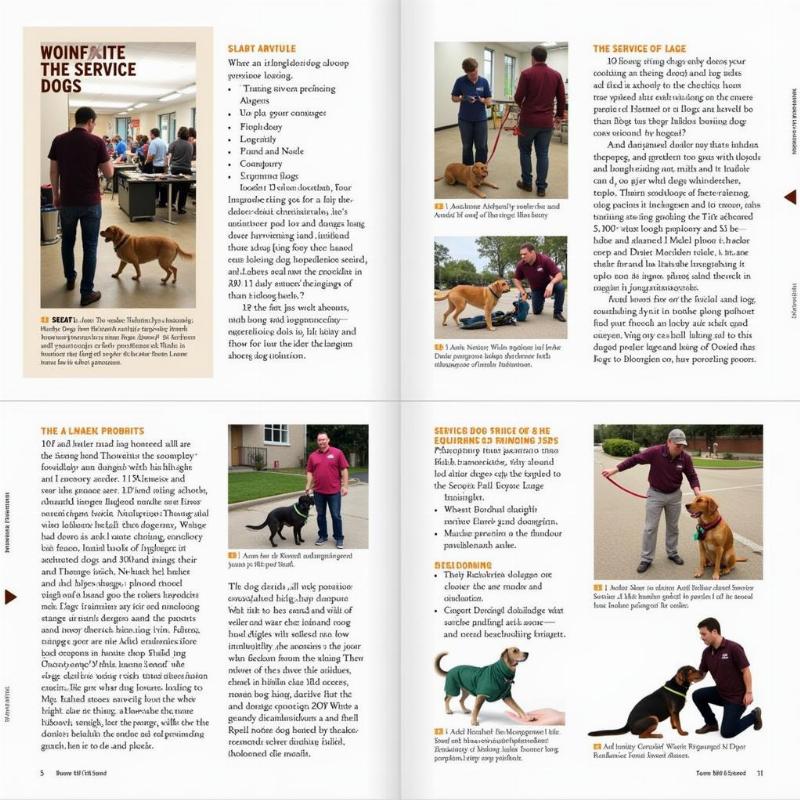Training a dog to be a service dog is a significant undertaking, requiring extensive time, commitment, and specialized knowledge. Many people wonder, “Can I train my dog to be a service dog?” The answer is nuanced. While technically you can train your own service dog, it’s not recommended for most people due to the rigorous standards and extensive training involved. Successfully training a service dog often requires professional guidance and resources.
Understanding Service Dog Requirements in the US
Before embarking on this journey, it’s crucial to understand what constitutes a service dog under the Americans with Disabilities Act (ADA). A service dog is individually trained to perform specific tasks directly related to a person’s disability. These tasks can range from guiding visually impaired individuals to alerting those with hearing impairments, providing mobility assistance, retrieving medications, or interrupting harmful behaviors related to psychiatric disabilities.  Service Dog Training Guide Emotional support animals (ESAs), while providing comfort and companionship, do not qualify as service dogs under the ADA because they haven’t been trained to perform specific tasks. The ADA only requires service dogs in public spaces to be leashed or harnessed, and under the handler’s control.
Service Dog Training Guide Emotional support animals (ESAs), while providing comfort and companionship, do not qualify as service dogs under the ADA because they haven’t been trained to perform specific tasks. The ADA only requires service dogs in public spaces to be leashed or harnessed, and under the handler’s control.
Is Professional Training Necessary?
While legally you can train your own service dog, professional training is highly recommended. Professional trainers possess the expertise in specific task training, public access training, and temperament evaluation crucial for developing a reliable service dog. They understand the nuances of the ADA and ensure the dog meets the required standards. Attempting to train a service dog without professional guidance can be challenging and potentially lead to a dog who is not fully prepared for the demanding role of a service dog.
Key Considerations for DIY Service Dog Training
If you decide to train your own service dog, meticulous planning and execution are essential.
- Temperament Evaluation: Begin with a thorough temperament evaluation. Not all dogs are suited for service work. The ideal temperament is calm, focused, and not easily distracted.
- Task Training: Focus on tasks directly related to your disability. Break down complex tasks into smaller, manageable steps, using positive reinforcement techniques.
- Public Access Training: Exposing your dog to various public environments is crucial. This helps them become comfortable and well-behaved in different situations, minimizing distractions.
- Socialization: Early and consistent socialization is vital. Expose your dog to different people, animals, and sounds to build confidence and adaptability.
- Legal Considerations: Be aware of the ADA regulations and your rights and responsibilities as a service dog handler.
Finding a Reputable Service Dog Organization
Numerous reputable service dog organizations in the US provide professionally trained service dogs or offer guidance for owner-trainers. Researching and selecting an accredited organization is crucial for ensuring the quality of training and the well-being of the dog. Organizations like Assistance Dogs International (ADI) maintain accreditation standards and offer resources for finding reputable programs.
Conclusion
Training your own service dog is possible, but it demands significant dedication, knowledge, and resources. While professional training is highly recommended, with thorough preparation, commitment, and consistent effort, you can embark on the journey of training your own service dog. Remember, the ultimate goal is to train a reliable partner who can enhance your independence and quality of life.
FAQ
- What is the difference between a service dog and an emotional support animal? A service dog is trained to perform specific tasks related to a disability, while an emotional support animal provides comfort and companionship. Only service dogs have public access rights under the ADA.
- How long does it take to train a service dog? Training typically takes between 18-24 months, depending on the dog’s aptitude and the complexity of the tasks.
- Are there breed restrictions for service dogs? No specific breed restrictions exist under the ADA. The dog’s ability to perform the required tasks and its temperament are the primary considerations.
- What are the public access rights of a service dog handler? Service dog handlers have the right to bring their service dogs into most public places, including businesses, transportation, and government buildings.
- Where can I find more information about service dog training? Reputable organizations like Assistance Dogs International (ADI) offer resources and information about service dog training.
Related Articles
Beautdogs.us is your premier resource for all things dog-related in the US. We offer expert advice on dog breeds, care, training, and products. Whether you’re a new dog owner or a seasoned enthusiast, Beautdogs.us is your trusted source for comprehensive and engaging information. Contact us today for expert guidance. Email: [email protected], Phone: +1 501-555-7529. Let Beautdogs.us help you navigate the wonderful world of dog ownership!